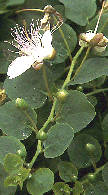Almost everyone knows that capers are the buds of a flowering plant, but usually nasturtiums get commandeered for parentage. Not so. Capers come from the caper bush (capparis spinosa), which grow wild around the Mediterranean. As the name indicates, this is a spiny shrub. If permitted to flower, it erupts into small white and pink blooms. The buds, if eaten before they are preserved, are said to be extremely bitter. We seldom eat them that way. Instead they are preserved, packed in a solution of vinegar and salt or sometimes just in salt (in which case they must be washed before they are eaten).
 Even when packed in brine, capers are too salty and bitter to be eaten alone. Their intense flavour is used to offset other milder-tasting dishes. This is the way they have been eaten for more than a thousand years. Reay Tannahill, in her wonderful gastronomical odyssey Food in History, notes that a 10th century caliph began a dinner with hors d’oeuvre featuring capers in “a sauce vermilion whose fragrant odors to the soul are blown....” and in 1570, Pope Pius X held a banquet which featured ten kinds of roasts including “stuffed spit roasted pigeons with sugars and capers sprinkled over them.” Even when packed in brine, capers are too salty and bitter to be eaten alone. Their intense flavour is used to offset other milder-tasting dishes. This is the way they have been eaten for more than a thousand years. Reay Tannahill, in her wonderful gastronomical odyssey Food in History, notes that a 10th century caliph began a dinner with hors d’oeuvre featuring capers in “a sauce vermilion whose fragrant odors to the soul are blown....” and in 1570, Pope Pius X held a banquet which featured ten kinds of roasts including “stuffed spit roasted pigeons with sugars and capers sprinkled over them.”
The sharp taste of capers was valued at a time when most spices were imported from the Far East and exorbitantly expensive. For example, peppercorns, which have a similar but less potent impact on taste buds, were weighed out by the berry. In the middle ages, a French serf could purchase his freedom with a pound of peppercorns. Far better to throw a few more capers into the stew.
As the European empire grew, the cost of spices declined but capers still played an important role in Mediterranean cooking. The Sieur de la Varenne, the 17th century writer of the first modern French cooking book, simmered game birds in caper sauces. Their astringency cut the taste of the fat in the rest of the sauce.
Today peppercorns are common and capers are thought to be a delicacy. But they aren’t expensive and a small jar will last a long time in the refrigerator. Capers give a zesty herbal edge to a simple oil and vinegar salad dressing. They are the signature ingredient to the classic fish dish “raie au beurre noir” in which skate is poached lightly and served with a sauce made of melted butter that is cooked to just burn and into which capers and a dash of caper juice are added.
|

